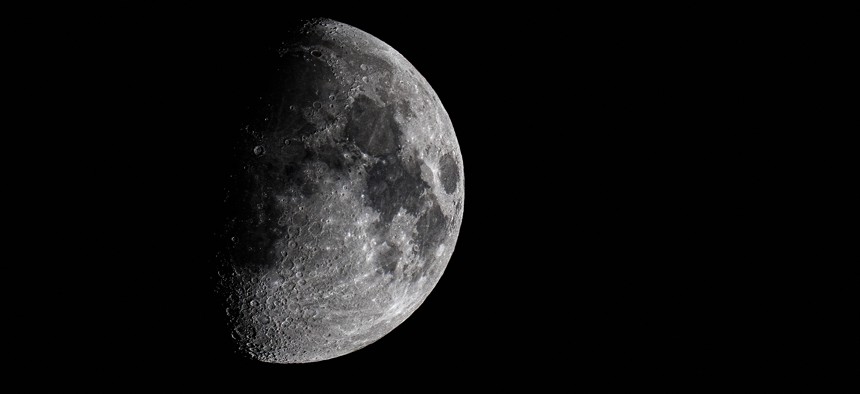NASA, Energy Collaborate on Lunar Experiment Exploring Dark Ages of the Universe

Brais Seara/Getty
The agencies are working together to develop a tool to survive the harsh conditions of night on the moon to measure radio frequencies and learn about the Dark Ages of the Universe.
NASA and the Department of Energy are developing an instrument that can survive the tough conditions of night on the far side of the moon to try to measure the Dark Ages of the Universe for the first time, according to an announcement on Tuesday.
Energy’s Office of Science, Brookhaven National Laboratory, the University of California Berkeley's Space Sciences Laboratory, and NASA’s Science Mission Directorate created the Lunar Surface Electromagnetics Experiment–Night—or LuSEE-Night—to understand the moon’s radio environment and try to “take a first look at a previously unobserved era in our cosmic history.”
Specifically, the Dark Ages of the Universe—which occurred between 380,000 to 400 million years after the origin of the universe, otherwise known as the Big Bang—are an important time in cosmological studies because they can offer new insight into the formation and evolution of the universe. The agencies noted that radio waves are the only signal that can be used to measure evidence from the Dark Ages, so LuSEE-Night gives researchers an opportunity to “learn how the first non-luminous matter evolved into the stars and galaxies that we see dominating the observable Universe today.”
The radio wave signals cannot be measured from Earth because of Earth’s “opaque ionosphere and the noise from Earth’s constant ‘pollution’ of the inner solar system with radio waves.” However, it should be possible to study such signals from the far side of the moon.
“LuSEE-Night is a fascinating experiment that will get us closer to observing something we’ve never been able to before—the Dark Ages signal,” said Asmeret Asefaw Berhe, the director of DOE’s Office of Science. “With this collaboration, DOE and NASA are setting conditions for successful exploration of the Dark Ages cosmology in the decades to come.”
LuSEE-Night will use deployable antennas and radio receivers to possibly observe sensitive radio waves from the Dark Ages for the first time. By having the instrument on the moon’s surface and measuring at the right time, several external sources of radio interference will be removed, such as radio noise from the Sun, Earth, Jupiter and Saturn.
According to the agencies, it will be a challenge for LuSEE-Night to “survive the harsh, cold and dark environment of the lunar night on the far side of the Moon long enough to collect and return data to Earth” because of large temperature fluctuations––250ºF during the day and -280ºF at night. The change in temperature will cause challenges for data transmissions and could cause the instrument to freeze or the mission to end early. As a result, the agencies stressed the importance of having technology that can handle these conditions.
“LuSEE-Night will operate during the cold temperatures of the 14-day lunar night, when no sunlight is available to generate power or heat,” said Joel Kearns, deputy associate administrator for exploration in NASA’s Science Mission Directorate. “In addition to the significant potential science return, demonstration of the LuSEE-Night lunar night survival technology is critical to performing long-term, high-priority science investigations from the lunar surface.”
If the instrument is successful, it will be a pathfinder to help develop larger future instruments to further measure radio frequencies—like the Dark Ages signals—that could not be measured otherwise.
“This measurement is very challenging; radio emission from the galaxy is very bright, and our Dark Ages signal is hiding behind it,” said Professor Stuart D. Bale of University of California, Berkeley, and the NASA principal investigator for LuSEE-Night.
“Every time we have opened a new frequency window in cosmology, we have unlocked new discoveries about the history of the Universe and our place within it,” Anže Slosar, Brookhaven National Lab Energy lead and LuSEE-Night science collaboration spokesperson, said.
LuSEE-Night will go to the moon on a future Commercial Lunar Payload Services flight. According to the agencies, through CLPS flights, NASA is buying a complete commercial robotic lunar delivery service, where it does not provide launch services, own the lander or lead landing operations.
This collaboration also further strengthens the agencies’ long-standing partnership to help space innovation and exploration.






